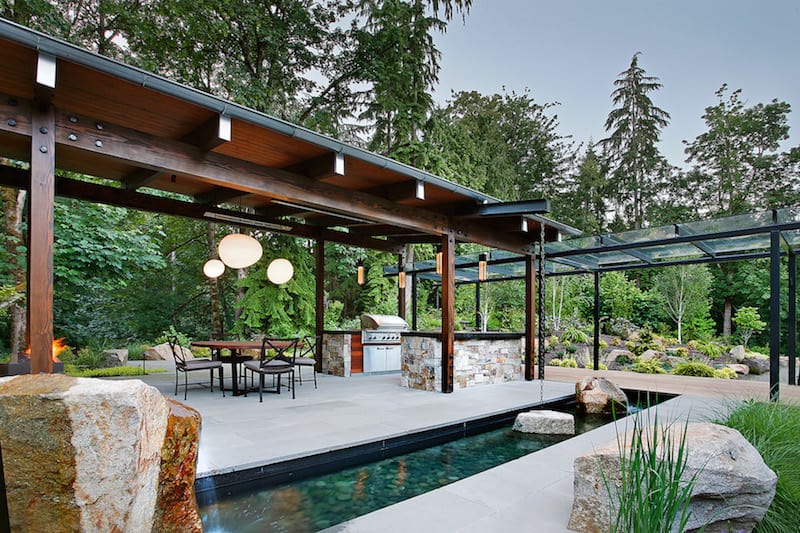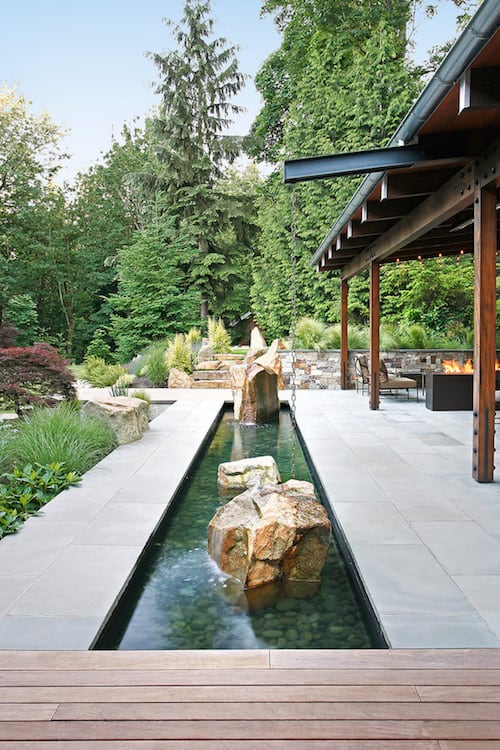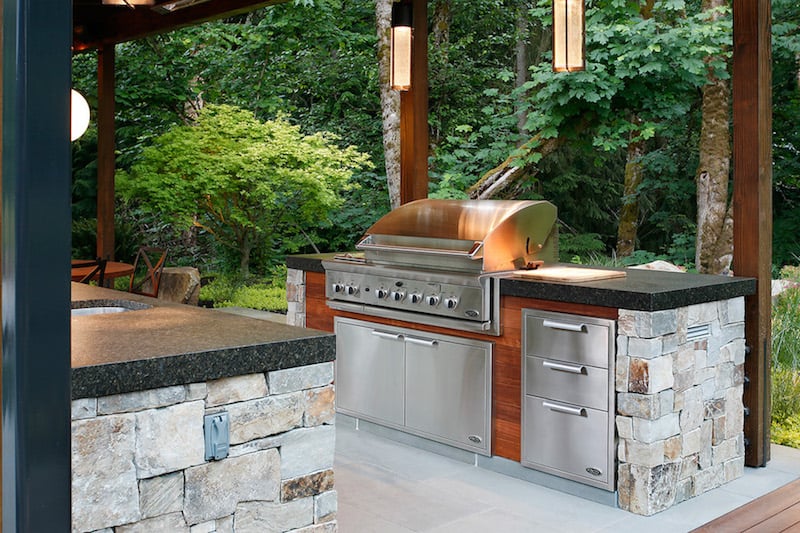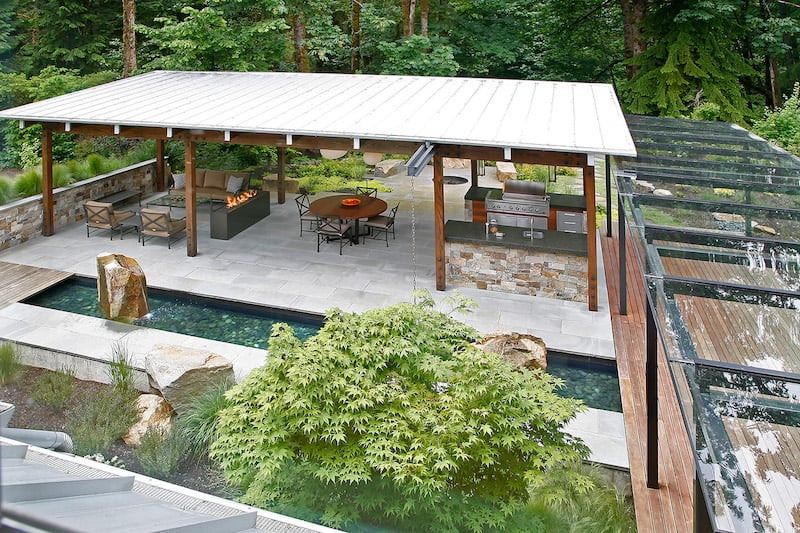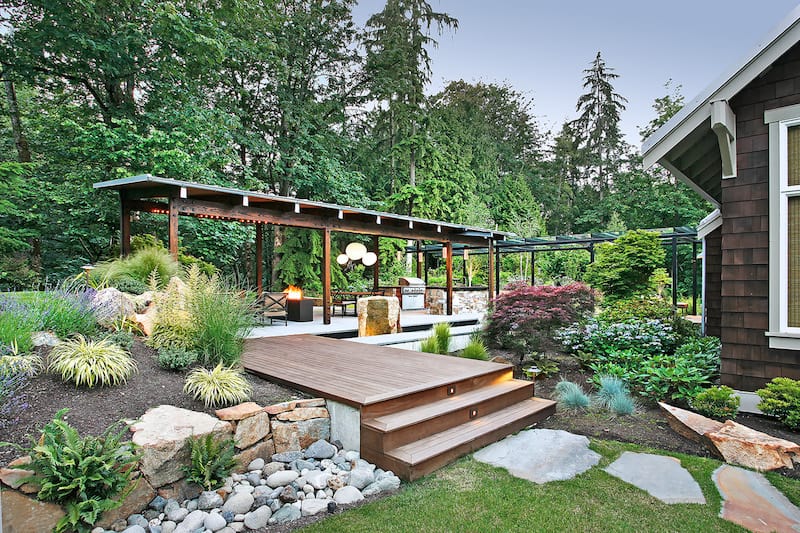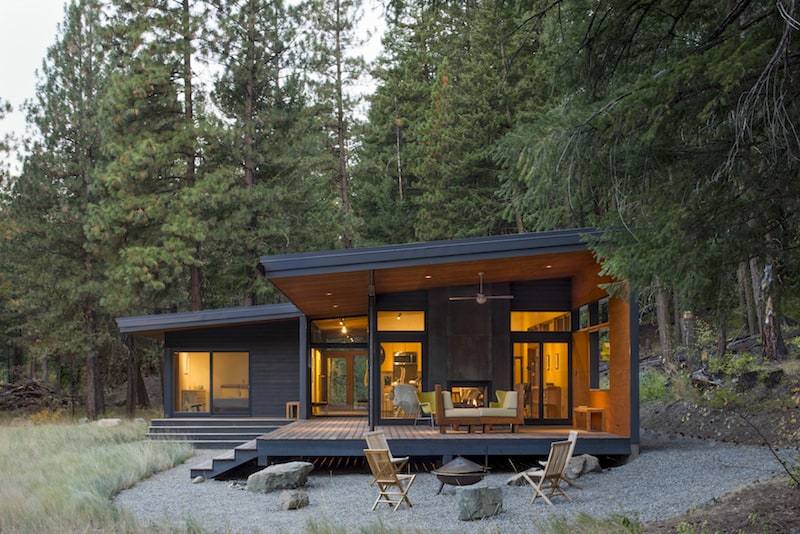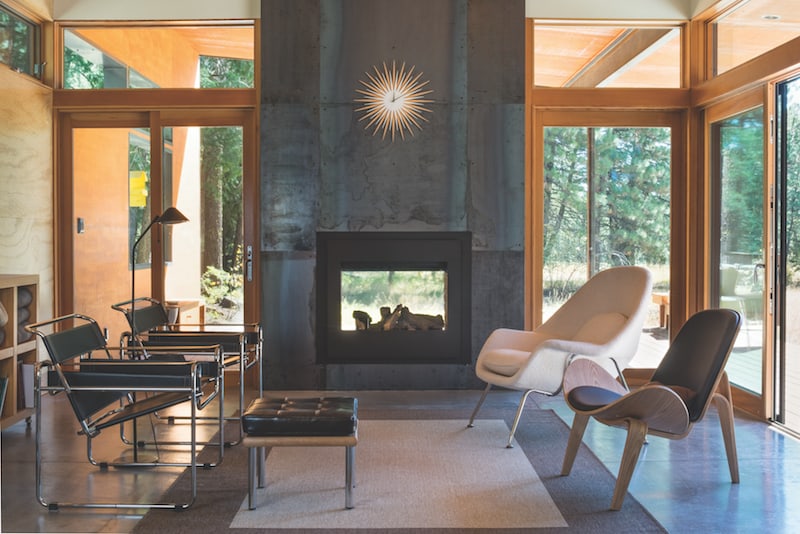Washington architects design outdoor rooms that flatter their rural settings
written by Melissa Dalton
Bothell: A Destination in the Landscape
Many backyards are perfectly serviceable, if a little uninspiring, with their standard-issue grass patch and cement patio. The backyard at this custom-built home on an 8-acre lot in Bothell was in a similar boat, only instead of grass, it had dirt. Lots and lots of dirt.
“ There was a smallish concrete patio, a barbecue that wasn’t covered, and some seating,” architect Joyce Puri of studiopuri remembered from her first visit to the site. “But they also had an enormous berm that was 5 feet high in some places.”
That dirt pile was edged by a ravine and second-growth trees, making for a fairly uninviting vista from inside the house. Having wrapped up interior renovations with interior designer Marilyn Deering of Deering Design Studio, the homeowners reached out to Puri and Rob Hutchison in 2014 to revamp the backyard. Aided by Deering, Chad Wichers of Studio 342 Landscape Architecture and contractor Roberts Group, the team crafted an outdoor pavilion that effectively merges the house with the natural beauty of the site.
As opposed to smaller city lots, which might create constraints from property lines and setbacks, this design was shaped by the organic sprawl of the landscape. Once all the dirt was hauled away, Puri said, “it was a lot of wide open space.”
photos by Mark Woods Photography
“It was about what the natural land wanted to do, where the trees were situated, and what views were opening themselves up and giving opportunities,” she said. The team nestled a long and linear pavilion in the landscape, then connected it to the house via a glass-canopied walkway, fashioned with an ipe deck and slim steel framework. Not only does the glass keep the path dry, it also “kept the profile low and ensured that light could get into the house.”
Under the pavilion roof, a kitchen, dining and lounging area are protected from the elements. The team installed distinct lighting groups to define each zone, from cylinder pendants in the kitchen to a clustered chandelier over the table to string lights above the couch. Stylistically, striking a balance between modern and rustic was the topic of many in-depth design decisions. Dry-stacked stonework and timber posts received a more streamlined treatment, as each stone was handpicked for its particular hue and shape, and custom metal brackets give the wood a refined look.
A 30-foot-long water feature, which can be seen from multiple angles inside and out, ties everything together. The water feature’s boulders reference the larger natural setting, while mellow up-lighting and the water’s soft gurgle foster a relaxed mood. Not only can the homeowners host large neighborhood gatherings in their new backyard destination, the space works for cozy family time around the fire on a misty night. “It just ts everything that it’s intended to do,” Puri said. “It doesn’t impose on the landscape.” Deering agreed, enjoying how the new outdoor space ts with the house. “ The outdoor rooms are a terrific extension of the indoor living room and kitchen,” she said. “All the rooms flow together beautifully, even though some are inside and enclosed and some are outside.”
Methow Valley: Maximizing Space
When Jason and Cheryl Quintana first visited the Methow Valley in 2009, it was love at first sight. The couple were visiting the region to cross-country ski, but quickly became enamored of its natural beauty and pace of life. “It was just so pretty, so quiet, and it felt so good [to be there],” Jason Quintana said. Realizing they wanted to return as often as possible, the Oregon-based couple started looking for land to purchase— the only question was how close they could live to the trails. Upon finding a buildable 1-acre lot that borders National Forest land and has access to a network of paths, the answer was very.
“We can ski in and out of the garage,” Quintana said. Naturally, any house the couple built on the property needed to integrate with the environment they love to explore. To do so, they opted to build small. In 2012, they hired architect Margo Peterson-Aspholm from Prentiss Balance Wickline Architects to create a 1,100-square-foot, two-bedroom cabin with a garage. “ They just wanted a small place that was very open to the exterior,”
Peterson-Aspholm said. As such, the modest home essentially hosts two living rooms: one inside and one outside, connected seamlessly by copious glass and several subtle design gestures. To start, Peterson-Aspholm tucked the 300-square-foot outdoor room neatly under the roof, then partially enclosed one side with a wall, making it feel apiece with the interior of the house. The wall’s window cutouts frame views of the forest, and the plywood cladding was carried back inside for a consistent look. A two-sided replace column with a see-through rebox acts as a striking focal point. “It’s one more detail that emphasizes this indoor/outdoor feel,” Peterson- Aspholm said.
photos by Eirik Johnson/Prentiss Balance Wickline Architects
Both sides of the replace are surrounded by the same untreated steel, its patina giving off an orange tint that echoes the bark on the ponderosa pines outside. “It’s a nice color that fits with the surroundings,” Peterson- Aspholm said. The cabin’s careful siting deftly bridges the forested hillside and meadow that form the lot. “We didn’t want to have the house out in the open,” she said. So they pushed it to the base of the hill, then cantilevered the floor over the foundation wall.
The effect is that the ipe deck “looks like it oats above the grass.” A few wide steps double as seats and act as additional graceful connection points, as though the outdoor living room is being extended into the meadow. “ The idea was an organic transition from interior to exterior, from the living room to the deck to the grassy meadow,” she said. Even though building smaller ultimately meant less room for the cabin’s two bedrooms—“We jokingly called them tiny and tinier,” Peterson-Aspholm said—a layout that removes the indoor/outdoor divide made perfect sense for such a nature-loving couple. “ The germ of the design was to celebrate the outdoors.”


